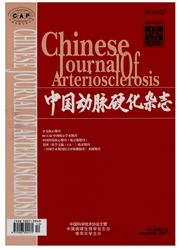

 中文摘要:
中文摘要:
目的尝试构建人血凝素样氧化型低密度脂蛋白受体1(LOX-1)基因双顺反子表达载体并检测其在293T细胞中的表达情况和生物学活性,为深入探讨LOX-1在动脉粥样硬化中的作用和以LOX-1为靶点建立干预机制治疗动脉粥样硬化奠定基础。方法首先根据Primer5.0软件设计引物,采用聚合酶链反应法以LOX-1 c DNA片段为模板扩增LOX-1基因完整编码区,克隆至T载体,经测序成功后亚克隆到双顺反子真核表达载体p IRES2-Ac GFP1-Nuc。利用脂质体转染法将双顺反子重组表达质粒转染至293T细胞,倒置荧光显微镜检测质粒转染情况。采用逆转录聚合酶链反应和免疫印迹法鉴定LOX-1基因在核酸和蛋白水平的表达,采用激光共聚焦检测LOX-1基因在293T细胞膜上的表达,激光共聚焦和流式细胞术检测表达在293T细胞膜上的LOX-1结合氧化型低密度脂蛋白(ox-LDL)的生物学活性。结果成功构建p IRES2-LOX-1双顺反子重组表达载体,将其转染293T细胞后,观察到绿色荧光蛋白基因的表达,初步表明LOX-1基因转染至293T细胞。进一步分子水平鉴定结果表明LOX-1基因在293T细胞核酸和蛋白水平均得到表达,激光共聚焦结果证明LOX-1基因在293T细胞膜上表达。最后激光共聚焦和流式细胞术结果证实表达在293T细胞膜上的人LOX-1基因可以结合氧化型低密度脂蛋白。结论成功构建人LOX-1基因双顺反子表达载体,在此基础上证明其在293T细胞膜上得到表达,并且具有结合ox-LDL的生物学活性,为后续体外研究其在动脉粥样硬化中的作用以及以此为靶点建立干预机制奠定了基础。
 英文摘要:
英文摘要:
Aim Trying to establish a lectin-like oxidized low density lipoprotein receptor-1( LOX-1) bicistronic gene expression vector and detect its expression and function in 293 T cell,to explore the role of LOX-1 in atherosclerosis and lay a foundation for establishing intervention mechanism of LOX-1 targets. Methods First human LOX-1 gene was obtained from human c DNA by PCR and cloned into T plasmid. After sequencing,recombinant T plasmid was subcloned into bicistronic eukaryotic expression plasmid p IRES2 Ac GFP1-Nuc. Next the bicistronic recombinant expression plasmid was transfected into 293 T cells by liposome. Plasmid transfection efficiency was detected by inverted fluorescence microscope. Then the expression of exogenous human LOX-1 gene and protein in 293 T cells was detected by RT-PCR and Western blot. The expression of human LOX-1 in 293 T cells membrane was detected by confocal laser. Finally LOX-1functions of binding with ox-LDL in 293 T cell membrane was detected by confocal laser and flow cytometry. Results The pI RES2-LOX-1 bicistronic recombinant plasmid was constructed successfully. After transfection,green fluorescent protein was detected and the abundant LOX-1 mRNA and protein were expressed in the transfected cells,moreover human LOX-1 were expressed in the 293 T cells membrane and could bind with ox-LDL. Conclusion We have successfully established a LOX-1 gene bicistronic expression vector and on the basis we testified human LOX-1 expressed in 293 T cells membrane and could bind with ox-LDL,which layed a foundation for further study of its effect in atherosclerosis and establishing intervention mechanism of LOX-1 targets.
 同期刊论文项目
同期刊论文项目
 同项目期刊论文
同项目期刊论文
 期刊信息
期刊信息
